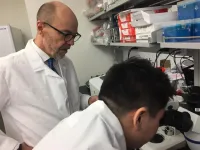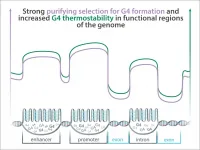Fruit flies lose their virginity lightly - and then become choosy
2021-06-29
(Press-News.org) Mate choice is important for females, who often invest much more energy in offspring than males. However, being too selective is a bad idea, as they might end up not mating at all. Biologists have wondered for a long time how females optimize their chances. Scientists at the University of Groningen have performed experiments with fruit flies that reveal the explanation: mating induces a behavioural change in female flies that makes them more choosy than when they are virgins. The results were published on 21 June in Nature Ecology and Evolution.
The fourteenth-century French philosopher Jean Buridan described a donkey who starved to death because he couldn't choose between two bales of hay. Evolutionary biologists have their own version of this decision-making problem: in many species, females invest more energy in reproduction than males. Thus, males try to mate with as many females as possible, while females are choosy as they have to select the best males to father their offspring. But, like with the philosopher's donkey, being too choosy may result in no offspring at all.
Aphrodisiac
In 2005, theoretical biologists suggested an explanation: what if female species' mate preference changes over time? This would be especially beneficial for organisms like flies, who store sperm for later use and mate multiple times. 'The sperm from the last mating is favoured for fertilization, so a first mating with an inferior male is of little consequence but it does ensure that the flies can reproduce', explains Jean-Christophe Billeter, associate professor of Neurogenetics of Social and Sexual Behaviour at the University of Groningen.
The explanation sounds plausible, but is it actually true? It turned out to be difficult to prove this in a controlled experiment. Billeter: 'It is very difficult to distinguish between learned behaviour and a programmed change in mate preference.' However, Billeter and his group have ample experience in studying mating behaviour in fruit flies. And he had noted changes in the way that the flies process cues after a first mating. 'For example, food acts as an aphrodisiac - but only in females who have mated before, not in virgins.' This means that virgin and mated females pay attention to different cues. Other scientists also described differences between virgin and mated flies.
Mutations
As there are lots of lines of fruit flies with specific mutations, this model organism would allow a careful study of how mating preference is governed. Billeter and his colleagues performed a series of experiments to study mate choice. The basic set-up was to observe one female with two males, each from a different strain. These were NL (a Dutch strain) and Tai (originating from West Africa). As fruit flies mate for about twenty minutes, all it takes is to wait to see which of the two males will mount the female. 'We observed thousands of Petri dishes, often overnight, each with two male flies and one female, to get our results.'
In a first experiment, they found a very clear result: virgin flies showed no preference for NL or Tai males. But mated females became choosy; they subsequently mated with Tai males in nearly 100 per cent of the experiments. 'It was a bit of luck to find such a huge difference between the strains', says Billeter. Another series of experiments was then performed to find out how this preference came to be. A male pheromone in the sperm fluid was already known to be responsible for mating-induced changes in female behaviour. And when virgin flies mated with male mutants without pheromones, they did not become choosy. This indicated that the females were not learning to become more choosy, but, in fact, underwent a programmed physiological change leading them to become more selective.
Puzzle
As the pheromone induces the production of a substance called 'juvenile hormone' in the females, the next step was to confirm that this hormone plays a role in developing selectiveness. And indeed, virgin females that were fed this hormone developed a preference for Tai males. But how are Tai and NL males distinguished? 'We figured pheromones were involved, so we then tested females without a sense of smell. And indeed, they did not develop a preference for Tai over NL males.'
At this stage of the study, Billeter visited a conference where Chih-Ying Su from the University of California in San Diego gave a talk on pheromone receptors in fruit flies. They started a collaboration and, using electrical recordings, the Su lab showed that the Or47b Odorant receptor neurons become less sensitive to pheromones after mating, as a result of juvenile hormone signaling. 'So, we figured that the juvenile hormone reduces the sensitivity of the flies' olfactory cells to this pheromone.' The final piece of the puzzle was finding the pheromone that activates Or47b. 'This was identified, and we predicted that Tai flies would have higher levels of this aphrodisiac pheromone than NL flies.' The hypothesis was confirmed: levels in Tai males were twice as high as in NL flies. And dousing NL flies with the pheromone made them as equally attractive as the Tai males.
Ants
This leads to a clear picture: to virgins, all males smell equally lovely. But mating reduces their sensitivity for an aphrodisiac pheromone, and thus induces preference for males with higher levels of this perfume. 'We could only discover this sequence of events because fruit flies are such a powerful model system, thanks to the availability of off-the-shelf tools to manipulate neurons and behaviour', acknowledges Billeter. 'But, now that we have confirmed, in this model, that mating actually flips a switch that induces mating preferences, we expect that researchers will be able to find this in other species as well.'
And there are wider implications. 'We have now discovered a trigger that can change the behaviour of an individual by changing how it responds to a cue. The first author of the paper, postdoc Philip Kohlmeier, is an expert in social insects, such as ants and bees. He is now eager to find out if similar triggers are involved in how social insects specialize in different classes, such as foragers and nurses.'
INFORMATION:
Reference: Philip Kohlmeier, Ye Zhang, Jenke A. Gorter, Chih-Ying Su and Jean-Christophe Billeter: Mating increases Drosophila melanogaster females' choosiness by reducing olfactory sensitivity to a male pheromone. Nature Ecology & Evolution, first online 21 June 2021.
[Attachments] See images for this press release:

ELSE PRESS RELEASES FROM THIS DATE:
2021-06-29
University of Colorado Boulder researchers have discovered that minuscule, self-propelled particles called "nanoswimmers" can escape from mazes as much as 20 times faster than other, passive particles, paving the way for their use in everything from industrial clean-ups to medication delivery.
The findings, published this week in the Proceedings of the National Academy of Sciences, describe how these tiny synthetic nanorobots are incredibly effective at escaping cavities within maze-like environments. These nanoswimmers could one day be used to remediate contaminated ...
2021-06-29
Research from the McKelvey School of Engineering at Washington University in St. Louis has found a missing piece in the puzzle of optical quantum computing.
Jung-Tsung Shen, associate professor in the Preston M. Green Department of Electrical & Systems Engineering, has developed a deterministic, high-fidelity two-bit quantum logic gate that takes advantage of a new form of light. This new logic gate is orders of magnitude more efficient than the current technology.
"In the ideal case, the fidelity can be as high as 97%," Shen said.
His research was published in May 2021 in the journal Physical Review A.
The potential of quantum computers is bound to the unusual properties of superposition -- the ability of a quantum system to contain many distinct properties, or states, ...
2021-06-29
Irvine, Calif., June 29, 2021 - Fireworks are synonymous in the United States with the celebration of Independence Day and other special events, but the colorful displays have caused a growing risk to public safety in recent years, according to a study by environmental health researchers at the University of California, Irvine.
Relying on real-time air quality measurements crowdsourced from a network of more than 750 automated sensors distributed throughout California, scientists from UCI's Program in Public Health found that short-term, extremely high-particulate-matter air pollution from the widespread ...
2021-06-29
This lobster tale begins a few years ago when the proprietor of a northeastern seafood restaurant publicly asserted that exposing lobsters to a little cannabis prior to cooking produced notable changes in their behavior and a less dramatic scene in the kitchen for all concerned, which was the Maine thing.
In a paper published online June 29, 2021 in the journal Pharmacology Biochemistry and Behavior, a team led by researchers at University of California San Diego School of Medicine, report on efforts to answer that burning, boiling and baked question. They obtained live lobsters (Homarus americanus) from a supermarket and exposed the crustaceans to up to 60 minutes of vaporized Δ9-tetrahydrocannabinol (THC) -- the principle psychoactive component of cannabis -- then ...
2021-06-29
June 29, 2021 - Nutley, NJ - Scientists from the Hackensack Meridian Center for Discovery and Innovation, working with collaborators from across the globe, uncovered the mechanism of action of a novel anti-tuberculosis drug that they have helped develop.
The new findings show how the enzyme inhibitor triaza-coumarin, or TA-C, is metabolized by the TB germs, which makes it effective in inhibiting the disease from within, like in a "Trojan horse" attack, according to the new paper in the journal Proceedings of the National Academy of Sciences.
"This is a promising new direction of research," said Thomas Dick, member of the CDI faculty. "We are hoping this work can make a difference in the ongoing fight against TB."
"The scientists at the CDI who specialize in ...
2021-06-29
For many years, researchers have been focused on developing technologies that can help us fight the imminent climate change crisis. They have one goal in common: finding sustainable energy sources that can replace the environmentally toxic fossil fuels. "Photocatalysts" that drive an artificial process that replicates photosynthesis (in which solar energy is converted to useful materials) are promising in this regard, given that we are able to develop the technology needed for them. Crystalline materials, such as strontium titanate (SrTiO3), which can serve as "photocatalysts" in solar devices, can lead us in the direction.
SrTiO3 is attractive owing to various other reasons ...
2021-06-29
Basic needs of disaster- and conflict-impacted refugees are often met by humanitarian relief goods and services, and until now little was known about how refugees create economic livelihood beyond immediate relief.
A new exploratory case study from Portland State University Associate Professor of Management Theodore Khoury reveals how Syrian refugees in the Za'atari camp reached beyond basic disaster relief support and leveraged social capital to create informal economic systems that helped improve their quality of life. The study, "Towards a theory of informal supply networks: An?exploratory case study of the Za'atari refugee camp," is published in the Journal of Operations Management and co-authored by ...
2021-06-29
PHILADELPHIA - The use of e-cigarettes, or vaping, causes serious damage to the lungs. After the novel coronavirus responsible for the respiratory disease COVID-19 emerged last year, there have been ongoing concerns about how vaping might impact risk of infection and severity of symptoms. Some evidence shows an increased risk of COVID-19 among those who vape. Research also shows a higher COVID-19 mortality rate in men compared to women, and men are more likely to vape than women. However, there is no evidence to link these two observations.
New research from Jefferson sheds light on this by showing that exposure to e-cigarette vapor increases levels of the coronavirus receptor in the lungs ...
2021-06-29
A 50% rise in the level of carbon dioxide (CO2) in the atmosphere could reduce rainfall in the Amazon as much as or even more than substitution of the entire forest by pasture. The rise in CO2 would reduce the amount of water vapor emitted by the forest, leading to a 12% annual drop in the volume of rainfall, while total deforestation would reduce rainfall by 9%.
These estimates are presented in a study published in Biogeosciences by scientists affiliated with the National Space Research Institute (INPE), the University of São Paulo (USP) and the University of Campinas (UNICAMP) in Brazil, and with Munich Technical University (TUM) in Germany.
“CO2 is a basic input for photosynthesis, so when it increases in the atmosphere, plant physiology ...
2021-06-29
Some regions of the human genome where the DNA can fold into unusual three-dimensional structures called G-quadruplexes (G4s) show signs that they are preserved by natural selection. When G4s are located in the regulatory sequences that control how genes are expressed or in other functional, but non-protein coding, regions of the genome, they are maintained by selection, are more common, and their unusual structures are more stable, according to a new study. Conversely, the structures are less common, less stable, and evolve neutrally outside of these regions, including within the protein-coding regions of genes themselves.
Together, these ...
LAST 30 PRESS RELEASES:
[Press-News.org] Fruit flies lose their virginity lightly - and then become choosy






